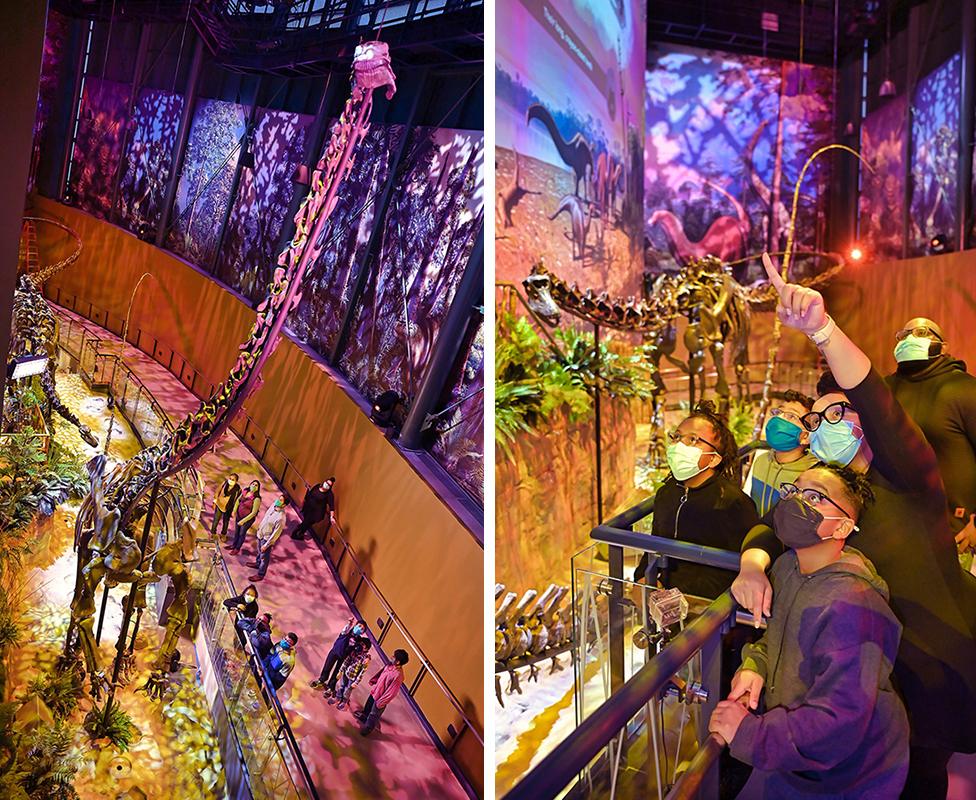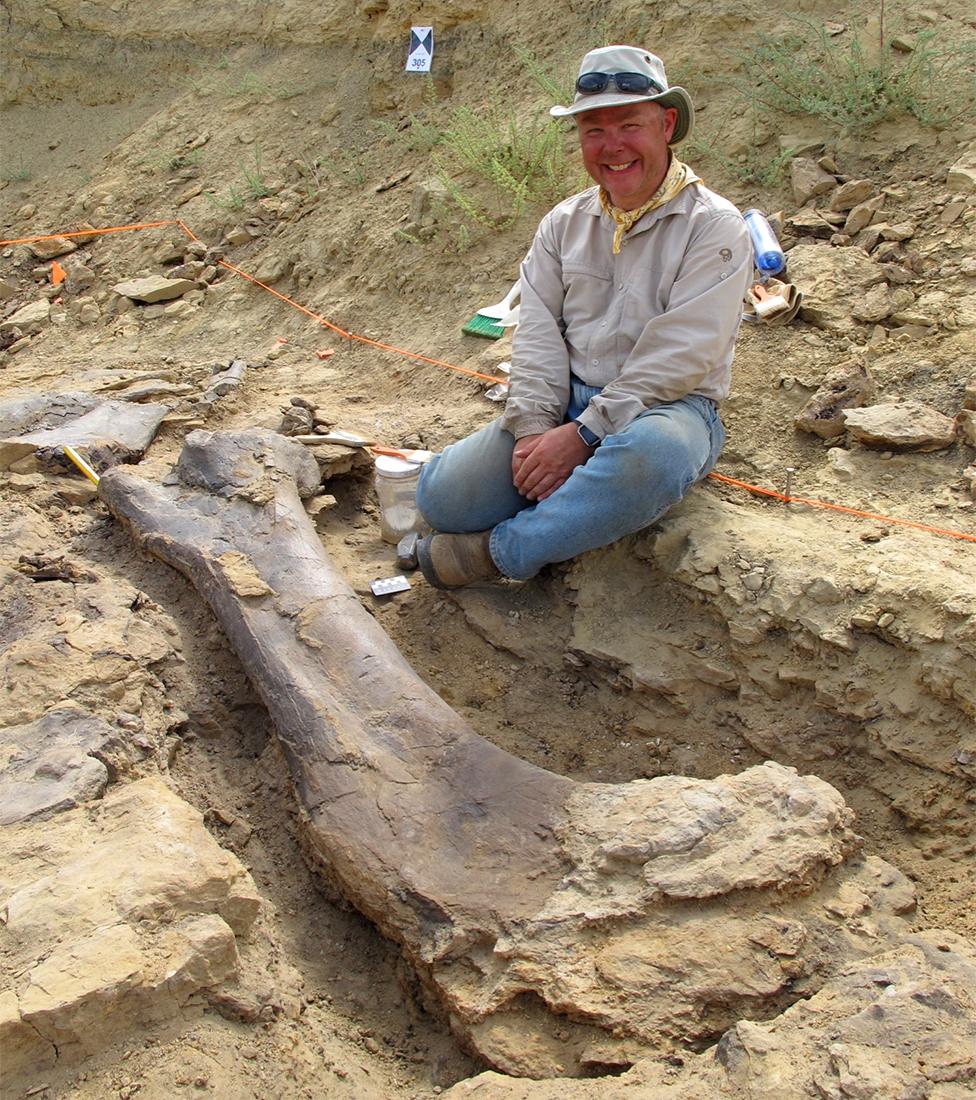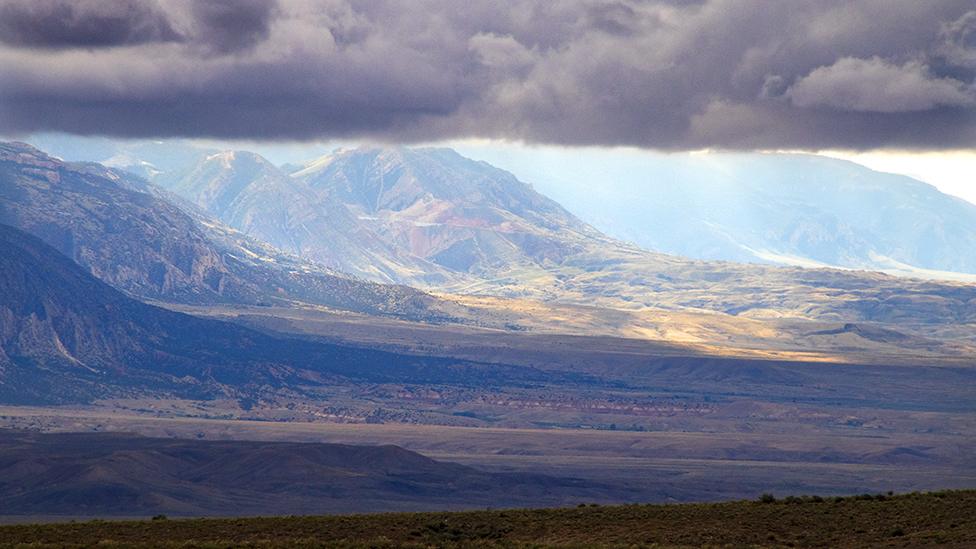Dinosaurs: Jurassic giants emerge from Wyoming badlands
- Published

One of the sauropods is displayed rearing up on its hind legs
Two giant sauropods offer a first glimpse of treasures likely to emerge from one of the world's most productive fossil sites.
The long-necked, long-tailed beasts are stars of the new Dinosphere show, external at The Children's Museum of Indianapolis.
Just over three years ago, they were encased in rock in Wyoming quarries.
"I'm utterly gobsmacked at how quickly this project has gone," said British palaeontologist Phil Manning.
The University of Manchester professor is a scientist-in-residence at the US museum, and led the excavation works on a section of ranch land they call the "Jurassic Mile".

Phil Manning's international team excavated the bones at Jurassic Mile at great speed
As the name suggests, this one-square-mile of ground in the Big Horn basin contains deposits from the Jurassic Period in Earth history.
The sauropods that have just gone on display are likely just a foretaste of what's expected to become one of the most productive fossil sites in the world.
The Children's Museum has staged its new dino stars together, but in very different poses. One is in the more classic on-all-fours posture; the other - which may surprise people - is seen rearing up on its hind legs.
"There've been multiple studies that have looked at the rearing of sauropod dinosaurs," explained Prof Manning.
"These animals would have done it probably either as a defence posture or to reach higher branches for higher browsing. It's quite logical. These animals had a centre of mass closer to the pelvis, so rearing up must have been possible. After all, how else could they mate?"

Wyoming is where many great dinosaur discoveries have been made
When the BBC was given exclusive access to the Jurassic Mile dig in 2019, it wasn't clear what type of sauropods were being unearthed.
The analysis is still ongoing, but they're almost certainly Diplodocid species that are new to science.
UK audiences would be very familiar with this sauropod grouping because a cast of Diplodocus carnegii stood at the entrance of London's Natural History museum for many years.
D. carnegii also came from Wyoming. Indeed, the state is where the Diplodocus genus was first identified by Othniel Charles Marsh.
The Yale University man had an infamous rivalry with a Philadelphia palaeontologist called Edward Drinker Cope. These two men went to war in the 1870s to prove their scientific prowess and intellectual superiority.
The collectors turned Wyoming and adjoining states into a fossil battlefield as they raced to dig up, describe and then display novel dinosaurs.
The Children's Museum had shown palaeontology can still move at speed, said Prof Manning - although, obviously, without the animosity and skulduggery of Marsh and Cope. Just good teamwork.
The Naturalis Biodiversity Center in the Netherlands was a key partner on the excavation, likewise Canada's Research Casting International company which prepared the fossil bones from one of the sauropods (the other was prepared by TCMI's own staff).

Dr Victoria Egerton is investigating the plant fossils at Jurassic Mile
The on-all-fours sauropod looks to have died in some sort of catastrophic flood event. Its remains were hemmed in with the bones of other animals by a big tree trunk.
The rearing sauropod could have died in a ponded area. Interestingly, lots of teeth from meat-eating dinosaurs known as theropods were found amongst the remains.
"There are a couple hypotheses for why we found so many theropod teeth. One is [that] this was a large animal, making quite the smorgasbord for other animals to find out on the plains," said Dr Jenn Anné, lead palaeontologist at The Children's Museum.
"So a couple of theropods could chomp down on it and have enough space between them that they didn't have to fight over it. Another hypothesis could be that this animal laid there for a fairly long period of time. Multiple individuals came up and took a nibble over time. It could also be that some of the teeth washed in from other areas."
The museum took out a 20-year lease on the Jurassic Mile, so the international team has a productive future ahead of it.
As well as the animal remains, there are well preserved fossil plants. These would tell us about the environment in which the dinosaurs lived, said Dr Victoria Egerton, a Manchester palaeobotanist who's also a scientist-in-residence at the museum.
"It's amazing to see our work go on show like this. It's what you dream of as a scientist. It will reach millions of people and I see myself as being very, very lucky," she told BBC News.
